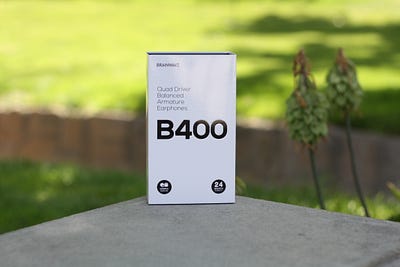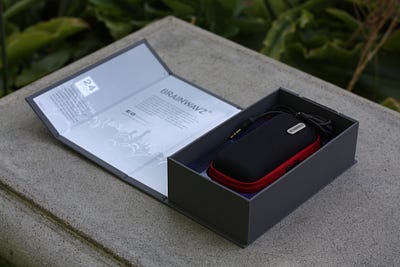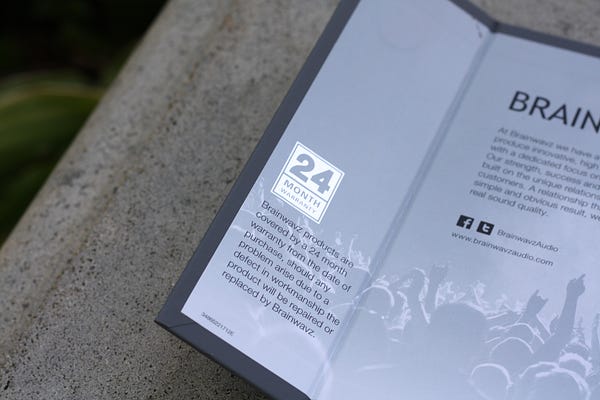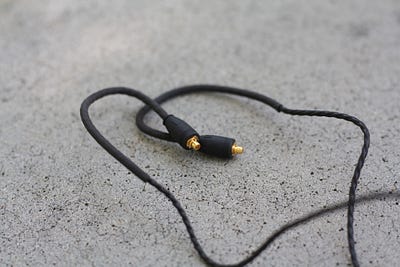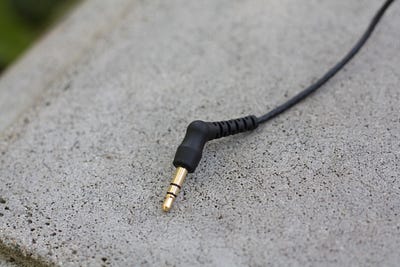BRAINWAVZ B400 REVIEW :
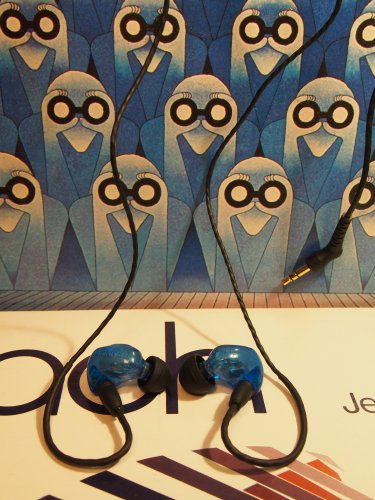
SOUND: 8/10
CONSTRUCTION: 8/10
DESIGN: 9/10
VALUE: 8/10

It make a long time I do not listen to Brainwavz earphones, lot of water have pass under the bridge since there first models that include S0, S1 single drivers and the nice sounding but complicate to wear Dual drivers R3 I buy in the past.
So, after hearing they lauch Multi BA’S universal custom models, I getvery interested and wait and wait and well, finally decide to try them after reading positive impressions about all B lineup, wich include B100 single BA, B200 dual BA’s and B400 quadruple BA’s. All them have housing construction made from 3D prints technology using liquid resin 3 pinters. I was sceptical about the benifit from such housing technology, but can confirm it achieve a degree of comfort that I rarely if ever wear with any unversal custom shaped iem.
The four BA’s of B400 are ‘’Made in USA’’and no, we will not know more than this. Is it Knowels or Optoma or what? One thing sure, these BA’s sound very good, never harsh or overly textured like china BA’s find in KZ, TRN and such more low budget oriented Multi drivers iem. Now, let’s see if the Brainwavz B400 is a good buy for the 200$ price.
CONSTRUCTION, DESIGN & ACCESSORIES :


When Unboxing the B400, you know this is a serious audio products you have. The presentation is really nice as it come in an elangant greay box that you don’t wanna put in garbage after...so find a use to it, like, storing your 50 iem, jewelery or gold plated denture.


In this box we have a good lot of accessories, wich I appreciate at this price range. We have a nice quality protective case, good lot of eatips inluding foam tips, and more importantly 2 mmxc cable-one with mic and other being standard. Again, all look of irreprochable quality.




Now, about the B400 housing, first thing is how small they are for a 4BA’s, wich explain too the level of comfort we get. The resin plastic is very slippy and fit perfectly any ears. The nozzle tough, have a rough look and no mesh, wich make it worrysome for unwanted particule or dust entering it, perhaps finding a eartips with mesh will prevent that. As well, the 3D resin printing make the housing trasparent at some place and opaque at other, for esthetical aspect thats a little disapointing because they would be so more beautifull if all perfectly translucide. MMCX connection is well implemented in housing and will must likely never brea. So, about durability i’m not that worry, perhaps the plastic can crack if beaten up, can’t tell for now.

As said, this are slippy iem, because the form design have an organic shape, wich is perfact for comfort and fitting, but can make connecting MMCX cable a little clumsy….but this is not really an issue. Just don’t change mmcx cable in front of a pool, a fire or a cliff, that’s all.
OVERALL SOUND IMPRESSIONS :

Having mostly heard cheaper multi BA’s earphones, I was a little worry that the Brainwavz B400 will sound either too sharp, harsh, bass anemic or unbalanced. In fact, I was begining loosing hope in multi BA’s budget earphones, wich explain why I decide to try slightly more expensive model. At 200$ the B400 must be well tuned right?? Well, i’m happy to say it is! At very first listen I know it was from another league of any sub-100$ iem I try, wich is why an audiophile will invest this amount of money that still is in the budget range as we know nowadays price can go above 1K as if its something normal (it isn’t). So, B400 offer a very well layered and revealing sound with good thick punch, well rendered sub timbre and energy, very present and immersive mids and nice highs sparkle without any invasive treble peaks. Its a very musical, balanced sound that is on the soft side without feeling warm due to well controled frequencies response.

AMPING isn’t really needed even if the B400 are 32ohm. Sound pressure being very high, any audio source will do, but again, I suggest a good one with ultimate clarity, like the Xduoo X20.
SOUNDSIGNATURE is W shape with emphasis on mid bass and extra resolution inmids section and lower highs, all that with an overall smoth treble presentation that do not push fowards texture.
SOUNDSTAGE is deeper than wider, being more intimate in an holographic way than airy and around your head. Itsthe trasparency of smooth sound layers that help overall definition. With pristine recorded track playing trough ultra clear audio source, you will be utterly impress by level of imaging this B400 can achieve.
SUB BASS have good timbre and separation, its not the rumbly type and will perhaps lack some ‘’humph’’ for the serious basshead that will must likely tend towards boomy bass as here the sub stay in its right spot and have good resolution and extension, it just isnt pumped up really. I do not feel bass player lack body, in fact, it just feel right to me. Anyway, when sub is pushed fowards like with the tracks ‘’Pick Six’’ from Gila, its far from sounding thin and have plenty of body, quite incredible for a BA performance really even if I still believe only dynamic drivers can move enough air to make sub more alive.
MID BASS punch is where the energic part come, its well rounded and nicely impactfull without being ultra textured or too fowards and bright, it have some softness to it wich make it refrain from mids bleeding, attack isn’t the fastest-tighest but resolution and separation compensate for that. Compared to must single dynamic or cheaper hybrids iem, it deal well with complex tracks and never struggle whatever how fast or intense is drums playing in middle of multiple instruments as we can find in fast jazz rock or power rock. Sure some extra weight would help for extra energy, but the punch have good liveliness nonetheless.
MIDS have soft timbre with good body and grip to it, it float above all rest of sound spectrum making them the more fowarded frequencies range even if we are far from an overly textured or bright presentation. I find all instrument in this range to have great agility and benifit from extra transparency, so we can either hear naturally the background instrument of a front signer or other instrument in classical quatuor or symphony. Madeleine Peyroux voice in ‘’Blue Alert’’ song is too die for, but that’s not all, the whole track feel very balanced and spot on, with every instrument righly placed without overly emphased peaks. As the sounstage is more on the intimate side, it’s perfect for a song like this because of great layering potential. With very complex overcrowded music, B400 will struggle to have as much definition than with pop, folk, jazz or classical, we talk about music that have multiple layers of electronic instruments with particular texture like electric guitar or distorted synth or pads, wich B400 do not like to deal with.
HIGHS aren’t overly emphased and I don’t think we are in analytical territory, here, its more the timbre and tone that give extra visibility instruments, as well as lower ranges tranparencies from low to upper mids. There a whole relaxed but agile presentation with the B400 that is hard to describe, like snare, hit hat or percussion are tigh but not particularly sparkly. This will be perhaps problematic for solo harpsichord or music style that benefit a hall like vast presentation, wich even B200 can do to some extend, but it will be less a good all arounder. I do not feel there real treble roll off before 15khz and I prefer it this way : smooth, well resolved and musical without too much echo that can veil lower frequencies or distract the ears. To me, the B400 is a very well tuned 4 balanced armature and the treble is excellent for this type of drivers that can be too sharp ,and it deliver plenty of microdetails in upper region to enjoy. Sure, perfection would be to have extra texture in some there and there….but, its perhaps to compensate an utopia that will make the cymbals sound splashy in they end wich is not the case here.
COMPARAISONS :

 VS Final Audio Design E4000 (130$) :
VS Final Audio Design E4000 (130$) :
Braiwavz B400 cost 50$ more than E4000 and have a 4BA’S configuration compared to single 6.4mm drivers of E4000.
Soundsignature are somewhat in same family but tuned differently, it tend towards neutral and balanced with slight bump in mid bass and mids, but the B400 have some bump in sub bass and treble too wich make them overall a hint brighter and sharper.
Soundstage is more holographic with the B400 while the E4000 feel more frontal and little wider with more transparent layer compared to a more hall like withe extra echo of B400.
Amping isn’t needed for B400 as they are more easy to drive even at 32ohm, E4000 benifit from powefull dap or extra amping due to low sound pressure.
BASS of B400 have more sub presence than the E4000 and slightly less mid bass punch and resolution, here E4000 show how even if smooth sounding he can have realistic timbre that give subtle extra body to kick and help a clearer separation with low bass. Sub bass of B400 is thicker and weightier wich will benifit for electronic music while the E4000 bass will benefit rock and jazz.
MIDS are more fowarded with the B400 and have more texture especially in upper mid range, wich give more grip to violin and clearer separation in not too complex music that do not have too much sub bass and highs emphasis. Overall mids timbre of E4000 feel more natural and transparent, but more in center stage too, wich can feel recessed for some.
HIGHS are more sparkly and have more decay with B400, being more fowards and sharp as well, there no treble roll off with these compared to E4000 tamed upper treble wich give more balance and neutrality to overall sound to the cost of softing the dynamic energy. B400 can sound sometime too sharp as well as unbalanced with for example complex jazz were the percussion can feel too fowards, but I think it will be a plus for some listener searching for extra sparkle and details.

 VS NiceHCK M6 (130$) :
VS NiceHCK M6 (130$) :
The M6 have a configuration of 1 dual dynamic drivers plus 4BA’s and is one of my favorite iem right now and an incredible sound value.
Soundsignature is more U shape with extra sub bass push while the W sounding B400 have someextra punch and mids.
Being more bassy, the M6 bass feel more weighty and pumped up insub bass, anddig surely deeper as well, its more bodied but the resolution is so so and it can mix up with midbass will the B400 have more natural timbre and control.
There some bass bleed from M6 giving extra warm to the mids that are more recessed than B400, where again, it have better resolution even if less treble emphasis than M6. Mids are better layered and have more clarity as well as amore balanced presentation with B400, where M6 can sometime have slight upper harshness, B400 feel more natural and transparent.
With the M6 we have more micro details, but more harshness too, percussion and snare are more fowards and linear sounding with rest of spectrum, again, B400 show its talent with a more mature tuning that do not have crazy treble peaks.
Soundstage of M6 is more around your head and wider, but can feel veiled by bass sometime, so the B400 have a deeper presentation.
Construction of M6 will surely survive any type of mistreatment, its very TOTL looking iem for the price, while the B400 look a little delicate. For accessories, M6 come with one cable and B400 with 2, both are standard quality, nothing phenomenal.
 CONCLUSION :
CONCLUSION :
The Brainwavz B400 is a great achievement in multiple BA’S tuning, transient response feeling very natural and lively, never too sharp or peaky, we have here a very musical sounding universal custom that is as confortable to wear than to listen to for long hours.
The fact it’s packed up with lot of accessories is another plus that justify the 200$ price as I think this earphones is a great all arounder that sound very good with lot of different music style too making it a keeper in the long term unlike other iem that will be more picky with sound rendering.
If you search for a soft but punchy, mid centric multi BA’S earphone, that give excellent imaging in an intimate ultra layered soundstage with great deepness to it, I think the B400 is an excellent choice.



























